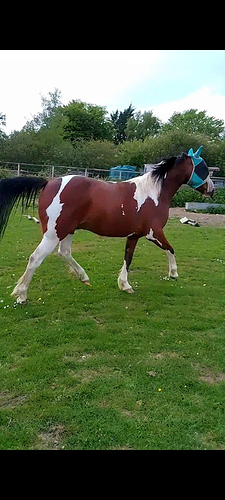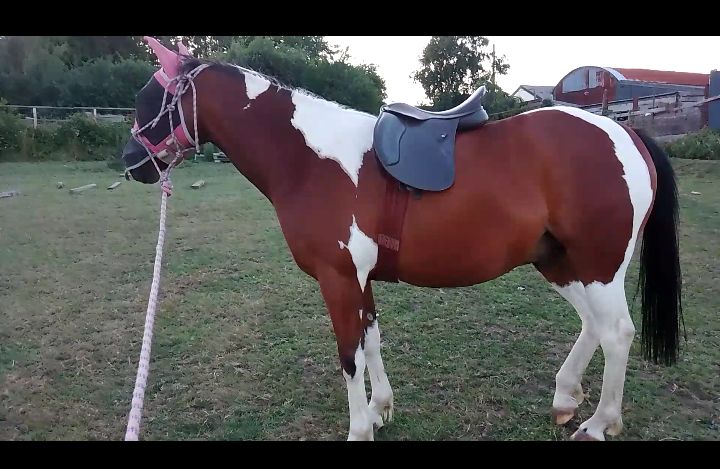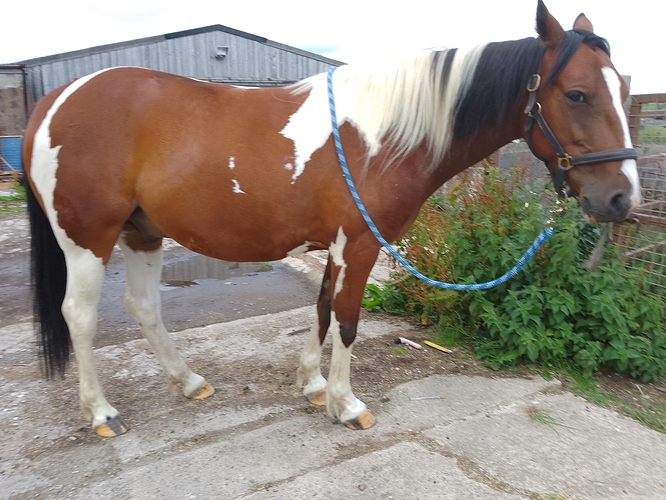Hello, I have never uploaded pics on here before so I’m not sure if this will work properly  sorry if this is the wrong section to post in!. My gelding has just turned six and he is 15 hands or 15.1 approx at the withers, another few inches at the bum. Sometimes he looks pretty bum high, sometimes not. I just wondered if anyone thinks he will stay bum high at six or maybe even out a little more? He’s warmblood x cob.Thank you xx( just trying saddles with a fitter here) I know he’s too chubby, trying to get some weight off him!
sorry if this is the wrong section to post in!. My gelding has just turned six and he is 15 hands or 15.1 approx at the withers, another few inches at the bum. Sometimes he looks pretty bum high, sometimes not. I just wondered if anyone thinks he will stay bum high at six or maybe even out a little more? He’s warmblood x cob.Thank you xx( just trying saddles with a fitter here) I know he’s too chubby, trying to get some weight off him!
The only way a 6yo grows, 99% of the time, is if work develops enough correct muscle and strength around the withers to ‘lift’ them out of the shoulders.
A good conformation shot will tell you if it’s actually butt-high, or if it’s a visual deception from his white markings and/or the curve of his back.
Ahh ok, thank you! I’m looking at travelling for lessons this summer, should help💗 he hasn’t done hardly any work this summer due to horrendous weather!
After age 5, any “growth” will be muscle development, not true (bone) growth. Is he truly “a few inches” taller behind than at the withers? If so, you will likely have a very, very difficult road ahead of you trying to ride him in a balanced manner. He doesn’t look anywhere near as downhill in the photos you provided as what you describe.
Last I measured, maybe 5 months ago he was about 4 inches higher on the bum, some angles he looks really bum high, others he looks almost level, perhaps it’s the deceptive white line as someone else said, Il measure again today 
Generally, yes. But truly there are some bigger horses who truly do grow inches after 5, way more than can be explained by just muscle development.
Regardless of breed, horses reach 98+% of their mature height by 36 months of age. So any true, skeletal growth after that will be negligible in the grand scheme of things. Obviously, the taller the horse is, the more inches there will be left to grow. But, as a proportion of their total height, not so much.
Not necessarily. I got my mare as a three year old and she was a little over 15:2 which was the size I wanted. She was a little thin and very undeveloped - she looked like a long yearling. The breeder said her mother grew until she was seven and I thought - sure. But this one grew to 16:2 by the time she was seven. I didn’t want her that big either. She was very awkward looking for a long time and was about as wide as a fish. When she finally stopped going up - she started to widen and fill out. Now she looks like a beached whale. I don’t think her legs got longer, I think her body got deeper and she got a little bit of withers. Her dam sire was Holsteiner and I think some of them are slow to grow and develop. But she definitely got taller than when she was three much to my dismay.
Right, the % of total height is still small, but it’s still a fact that some horses absolutely do grow skeletally taller after 5, in ways that can’t possibly be just due to muscle developing and lifting the shoulder sling
Most are absolutely done, barring work-related height increases, by 5 or so. It’s just not true that anything beyond that is always related to muscle development and support
You’re splitting hairs here for some reason, though.
Some horses may have a very, very, very minimal amount of growing left to do early in their five year old year. But that is far outside the norm and never significant compared to the horse’s overall height.
It’s true for all horses. I didn’t say there was “no” growth after age 5. I said TRUE - as in, skeletal - growth after age 5 is minimal. Insignificant in the grand scheme of the horse’s total height. Which has been thoroughly documented via research for decades now.
Horses “grow” after maturity due to muscle development. I bought a 14.3 coming 5 year old who measured 15.1 at age 7 and for the reminder of his working career. After he retired, he was back to measuring 14.3 again.
Many, MANY factors can impact a horse’s measured height. Where they are in their trim cycle, whether they are shod or barefoot, the position of their head and neck, the measuring instrument, and any tension (or lack thereof) they are feeling, just to name a few. Not to mention the frightening number of people who measure height way, way further up the horse’s neck than the actual wither position, which will add several inches to most horses…
But again, while that is true for the vast majority of horses, there are 100% horses who skeletally grow more than minimally after 5. They aren’t common, but I wouldn’t say it’s rare either.
My own WB grew about 1" between 6 and 7, and never shrunk back after I stopped working him
If there can be outliers who are finished growing in height at 3 or 4, why can’t there be those who truly don’t finish until 6-7?
Humans do this all the time - there’s a normal range of growth, but some finish earlier, some finish later.
1” falls into the “minimal” category, though.
Perhaps this is a definition/translation issue. As a scientist, when I say “significant”, I mean statistically significant. A single outlier individual is not statistically significant. Nor is an inch.
It’s not the outliers who finish growing at 3 - if we are discussing height. Most do, give or take 2%. Which is a minor difference when it comes to horse height.
Plenty of horses finish growing at 6-7. I never said they don’t. But they do not add a full hand of height after age 5, unless they are growing to unheard of sizes.
My KWPN gelding grew 3 inches between his 5th year(16.3 hh) and the end of his 7th year (17.2 hh). It wasn’t due to muscle development. He was an outlier.
Exactly - mine has gone from 16.1 as a 5 y/o to 16.3 as a 6 y/o and I think he may hit 17h by the end of the year. One person can say significant and mean statistically significant, but if you’re 5’1’’ buying a 16.1h horse thinking its done growing, ending up with something that is almost 17h feels pretty significant.
Not to mention that even an inch of a difference, while a small portion of the horse’s overall height, can make a huge (significant?) difference in the horse’s balance if changes them from a butt high baby to even from withers to croup.
In my experience with raising horses I find that by 6 they have reached their height max. What you will not want to hear is that at 5-6 sometimes they can really fill out…  Your boy looks to have that covered.
Your boy looks to have that covered.
he may just be a horse with downhill build. Getting some weight off will really help him ( i know you are working on it).
Exceptions are just that: exceptions.
Thank you, yes monitoring his weight carefully seems to have helped, he’s definitely lost some now x
Have to say horses DO GROW after age 6yrs, often significantly. We have sporthorses, tall genetically. We breed and raise them for ourselves. We follow older feeding practices of minimal grain, lots of pasture and forage. This allows slower, balanced growth, not overloading young bone, promote a long, SOUND work life. This is opposite of the more common, early overfeeding, as is done with show youngsters wearing layers of fat.
All of ours added inches after age six, though mares added less, a couple inches. Geldings added quite a bit more, from four to six inches. Two of the biggest growers were from the same mare, full brothers. One was gelded at 9 months, he added 6 inches after age six, ended up 18.2h. We had to sell him at 17.2h, too big for our uses. He finally quit growing at age 8yrs, using a stick to measure, not guessing. We then went to later age gelding, with them being full yearlings or more, to keep them smaller! Still regularly got at least 4 inches more after age 5. They end up in the 16.3 to 17h range at age 7yrs.
I do think our feeding program influences how fast ours mature. They are slim, never fat, early growth is not pushed with lots of “manufactured feed products, volumes of supplements that fix everthing,” They eat actual corn and oats, with vitamins and selenium supplemented. They have as much hay and good pasture as they wish to clean up. They start muscling up when they go into regular training around age 4yrs. They stay sound into their twenties, in work.
Dr. Deb Bennett’s old studies showed horses do not stop growing at age 6yrs. And also that “there are no early maturing” breeds of horses. They all take 6 years to mature their bones, with bigger animals taking longer to finish maturing.
Stallions used here were big, wide, muscular types, 16h to 16.2 ranges, but not draft horses. Mares were 16.2h to 17h, sport horse types.



